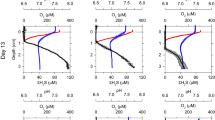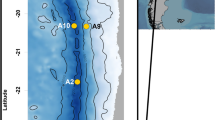Abstract
The effects of changes in vertical and horizontal microscale gradients of oxygen and sulfide on meiofaunal distributions were examined in laboratory microcosms. Specifically, the effect of tube abandonment and reestablishment by macro-infauna on the distribution of subsurface turbellarians, gnathostomulids and gastrotrichs was studied. Meiofauna responded rapidly (within 6 h) to changing sediment chemistry, consistently trying to reoccupy optimal habitat. Every subsurface taxon had a preferred suboptimal habitat which it occupied primarily during transit from deteriorating to newly established optimal habitat. Only during this time did the distribution of ecologically similar taxa overlap substantially. Changes in oxygen and sulfide gradients could explain most but not all of the response; food availability might also be important. Oxybios consistently chose oxic suboptimal microhabitat. Thus behaviorally, as well as biochemically and ecologically, thiobios represent a distinct group among the meiofauna.
Similar content being viewed by others
Literature cited
Aller, J. Y., Aller, R. C. (1986). Evidence for localized enhancement of biological activity associated with tube and burrow structures in deep-sea sediments at the HEBBLE site, western North Atlantic. Deep-Sea Res. 33: 755–790
Aller, R. C. (1983). The importance of the diffusive permeability of animal burrow linings in determining marine sediment chemistry. J. mar. Res. 41: 299–322
Aller, R. C. (1984). The importance of relict burrow structrues and burrow irrigation in controlling sedimentary solute distributions. Geochim. cosmochim. Acta 48: 1929–1934
Aller, R. C., Yingst, J. Y. (1978). Biogeochemistry of tube-dwellings: a study of the sedentary polychaete Amphitrite ornata (Leidy). J. mar. Res. 36: 201–254
Aller, R. C., Yingst, J. Y. (1985). Effects of the marine depositfeeders Heteromastus filiformis (Polychaeta), Macoma balthica (Bivalvia), and Tellina texana (Bivalvia) on average sedimentary solute transport, reaction rates, and microbial distributions. J. mar. Res. 43: 615–645
Aller, R. C., Yingst, J. Y., Ullman, W. J. (1983). Comparative biogeochemistry of water in intertidal Onuphus (Polychaeta) and Upogebia (Crustacea) burrows: temporal patterns and causes. J. mar. Res. 41: 571–604
Alongi, D. M. (1985). Microbes, meiofauna, and bacterial productivity on tubes constructed by the polychaete Capitella capitata. Mar. Ecol. Prog. Ser. 23: 207–208
Baillie, P. W. (1986). Oxygenation of intertidal estuarine sediments by benthic microalgal photosynthesis. Estuar. cstl Shelf Sci 22: 143–159
Bark, A. W., Goodfellow, J. G. (1985). Studies on ciliated Protozoa in eutrophic lakes: 2. Field and laboratory studies on the effects of oxygen and other chemical gradients on ciliate distribution. Hydrobiologia 124: 177–188
Bell, S. S. (1983). An experimental study of the relationship between below-ground structure and meiofaunal taxa. Mar. Biol. 76: 33–39
Bell, S. S., Woodin, S. A. (1984). Community unity: experimental evidence for meiofauna and macrofauna. J. mar. Res. 42: 605–632
Berghe, M. V., Bergmans, M. (1981). Differential food preferences in three co-occuring species of Tisbe (Copepoda, Harpacticoida). Mar. Ecol. Prog. Ser. 4: 213–219
Berner, R. A. (1963). Electrode studies of hydrogen sulfide in marine sediments. Geochim. cosmochim. Acta 27: 563–575
Boaden, P. J. S. (1975). Anaerobiosis, meiofauna and early metazoan evolution. Zoologica Scr. 4: 21–24
Boaden, P. J. S. (1977). Thiobiotic facts and fancies (aspects of the distribution and evolution of anaerobic meiofauna). Mikrofauna Meeresbod. 61: 45–63
Boaden, P. J. S., Platt, H. M. (1971). Daily migration patterns in an intertidal meiobenthic community. Thalassia jugosl. 7: 1–12
Carman, K. R., Thistle, D. (1985). Microbial food partitioning by three species of benthic copepods. Mar. Biol. 88: 143–148
Crezee, M. (1976). Solenofilomorphidae (Acoela): major component of a new turbellarian association in the sulfide system. Int. Revue ges. Hydrobiol. 61: 105–129
Decho, A. W., Castenholz, R. W. (1986). Spatial patterns and feeding of meiobenthic copepods in relation to resident microbial flora. Hydrobiologia 131: 87–96
Eckman, J. E. (1985). Flow disruption by an animal-tube mimic affects sediment bacterial colonization. J. mar. Res. 43: 419–435
Farris, R. A., Lindgren, E. W. (1984). A posteriori investigation of spatial arrangements in Gnathostomulida and Copepoda. Int. Revue ges. Hydrobiol. 69: 443–450
Felbeck, H., Liebezeit, G., Dawson, R., Giere, O. (1983). CO2 fixation in tissues of marine oligochaetes (Phallodrilus leukodermatus and P. planus) containing symbiotic, chemoautotrophic bacteria. Mar. Biol. 75: 187–191
Fenchel, T. M. (1968). The ecology of marine microbenthos, II. The food of marine benthic ciliates. Ophelia 5: 73–121
Fenchel, T. M., Jørgensen, B. B. (1977). Detritus food chains of aquatic ecosystems: the role of bacteria. Adv. microb. Ecol. 1: 1–58
Fenchel, T. M., Riedl, R. J. (1970). The sulfide system: a new biotic community underneath the oxidized layer of marine sand bottoms. Mar. Biol. 7: 255–268
Fox, C. A., Powell, E. N. (1986). Meiofauna and the sulfide system: the effects of oxygen and sulfide on the adenylate pool of 3 turbellarians and a gastrotrich. Comp. Biochem. Physiol. 85A: 37–44
Fox, C. A., Powell, E. N. (1987). The effect of oxygen and sulfide on CO2 production by three acoel turbellarians. Are thiobiotic meiofauna aerobic? Comp. Biochem. Physiol. 86A: 509–514
Gamble, J. C. (1971). The responses of the marine amphipods Corophium arenarium and C. volutator to gradients and to choices of different oxygen concentrations. J. exp. Biol. 54: 275–290
Giere, O., Liebezeit, G., Dawson, R. (1982). Habitat conditions and distribution pattern of the gutless oligochaete Phallodrilus leukodermatus. Mar. Ecol. Prog. Ser. 8: 291–299
Gray, J. S., Johnson, R. M. (1970). The bacteria of a sandy beach as an ecological factor affecting the interstitial gastrotrich Turbanella hyalina Schultz. J. exp. mar. Biol. Ecol. 4: 119–133
Hummon, W. D. (1974). Intertidal marine Gastrotricha from Columbia. Bull. mar. Sci. 24: 396–408
Jensen, P. (1987). Differences in microhabitat, abundance, biomass and body size between oxybiotic and thiobiotic free-living marine nematodes. Oecologia 71: 564–567
Jørgensen, B. B. (1977). The sulfur cycle of a coastal marine sediment (Limfjorden, Denmark). Limnol. Oceanogr. 22: 814–832
Kristensen, E. (1981). Direct measurement of ventilation and oxygen uptake in three species of tubiculous polychaetes (Nereis spp.). J. comp. Physiol. 145: 45–50
Meadows, P. S., Deans, E. A., Anderson, J. G. (1981). Responses of Corophium volutator to sediment sulphide. J. mar. biol. Ass. U.K. 61: 739–748
Meyers, M. B., Fossing H., Powell, E. N. (1987). Micro-distribution of interstitial meiofauna, oxygen and sulfide gradients, and the tubes of macro-infauna. Mar. Ecol. Prog. Ser. 35: 223–241
Okubo, A. (1980). Diffusion and ecological problems: mathematical models. Springer-Verlag, New York
Ott, J. A. (1972). Determination of faunal boundaries of nematodes in an intertidal sand flat. Int. Revue ges. Hydrobiol. 57: 645–663
Powell, E. N. (1977). Particle size selection and sediment reworking in a funnel feeder, Leptosynapta tenuis (Holothuroidea, Synaptidae). Int. Revue ges. Hydrobiol. 62: 385–408
Powell, E. N., Bright, T. J. (1981). A thiobios does exist-gnathostomulid domination of the canyon community at the East Flower Garden brine seep. Int Revue ges. Hydrobiol. 66: 675–683
Powell, E. N., Bright, T. J., Woods, A., Gittings, S. (1983). Meiofauna and the thiobios in the East Flower Garden brine seep. Mar. Biol. 73: 269–283
Powell, E. N., Crenshaw, M. A., Rieger, R. M. (1979). Adaptations to sulfide in the meiofauna of the sulfide system. I. 35S-sulfide accumulation and the presence of a sulfide detoxification system. J. exp. mar. Biol. Ecol. 37: 57–76
Powell, E. N., Crenshaw, M. A., Rieger, R. M. (1980). Adaptations to sulfide in sulfide-system meiofauna. End products, of sulfide detoxification in three turbellarians and a gastrotrich. Mar. Ecol. Prog. Ser. 2: 169–177
Ray, A. J., Aller, R. C. (1985). Physical irrigation of relict burrows: implications for sediment chemistry. Mar. Geol. 62: 371–379
Reise, K. (1981a). Gnathostomulida abundant alongside polychaete burrows. Mar. Ecol. Prog. Ser. 6: 329–333
Reise, K. (1981b). High abundance of small zoobenthos around biogenic structures in tidal sediments of the Wadden Sea. Helgoländer wiss. Meeresunters. 34: 413–425
Reise, K. (1983a). Biotic enrichment of intertidal sediments by experimental aggregates of the deposit-feeding bivalve Macoma balthica. Mar. Ecol. Prog. Ser. 12: 229–236
Reise, K. (1983b). Experimental removal of lugworms from marine sand affects small zoobenthos. Mar. Biol. 74: 327–332
Reise, K. (1984). Free-living Platyhelminthes (Turbellaria) of a marine sand flat: an ecological study. Mikrofauna mar. 1: 1–62
Reise, K., Ax, P. (1979). A meiofaunal “thiobios” limited to the anaerobic sulfide system of marine sand does not exist. Mar. Biol. 54: 225–237
Revsbech, N. P. (1983). In-situ measurement of oxygen profiles of sediments by use of oxygen micro-electrodes. In: Gnaiger, E., Forstner, H. (eds.) Polarographic oxygen sensors. Springer Verlag, Berlin, p. 265–273
Revsbech, N. P., Jørgensen, B. B., Blackburn, T. H. (1980a). Oxygen in the sea bottom measured with a microelectrode. Science (Wash., D. C.) 207: 1355–1356
Revsbech, N. P., Jørgensen, B. B., Blackburn, T. H., Cohen, Y. (1983). Microelectrode studies of the photosynthesis and O2, H2S, and pH profiles of a microbial mat. Limnol. Oceanogr. 28: 1062–1074
Revsbech, N. P., Sørensen, J., Blackburn, T. H., Lumholt, J. P. (1980b) Distribution of oxygen in marine sediments measured with microelectrodes. Limnol. Oceanogr. 25: 403–411
Revsbech, N. P., Ward, D. M. (1983). Oxygen microelectrode that is insensitive to medium chemical composition: use in an acid microbial mat dominated by Cyanidium caldarium. Appl. envirl Microbiol. 45: 755–759
Revsbech, N. P., Ward, D. M. (1984). Microprofiles of dissolved substances and photosynthesis in microbial mats measured with microelectrodes. In: Cohen, Y., Castenholz, R. W., Halvorson, H. W. (eds.) Microbial mats: stromatolites. Alan R. Liss Inc., New York, p. 171–188
Schäfer, W. (1972). Ecology and palaeoecology of marine environments. The University of Chicago Press, Chicago
Shick, J. M. (1976). Physiological and behavioral responses to hypoxia and hydrogen sulfide in the infaunal asteroid Ctenodiscus crispatus. Mar. Biol. 37: 279–289
Sørensen, J. Jørgensen, B. B., Revsbech, N. P. (1979). A comparison of oxygen, nitrate, and sulfate respiration in coastal marine sediments. Microb. Ecol. 5: 105–115
Sterrer, W., Rieger, R. (1974). Retronectidae — a new cosmopolitan marine family of Catenulida (Turbellaria). In: Riser, N., Morse, M. (eds.) The biology of the Turbellaria. McGraw-Hill Book Co., New York, p. 63–92
Waslenchuk, D. G., Matson, E. A., Zajac, R. N., Dobbs, F. C., Tramontano, J. M. (1983). Geochemistry of burrow waters vented by a bioturbating shrimp in Bermudian sediments. Mar. Biol. 72: 219–225
Watzin, M. C. (1985). Interactions among temporary, and permanent meiofauna: observations on the feeding and behavior of selected taxa. Biol. Bull. mar. biol. Lab. Woods Hole 169: 397–416
Wieser, W., Ott, J., Schiemer, F., Gnaiger, E. (1974). An ecophysiological study of some meiofauna species inhabiting a sandy, beach at Bermuda. Mar. Biol. 26: 235–248
Author information
Authors and Affiliations
Additional information
Communicated by R. S. Carney, Baton Rouge
Rights and permissions
About this article
Cite this article
Meyers, M.B., Powell, E.N. & Fossing, H. Movement of oxybiotic and thiobiotic meiofauna in response to changes in pore-water oxygen and sulfide gradients around macro-infaunal tubes. Marine Biology 98, 395–414 (1988). https://doi.org/10.1007/BF00391116
Accepted:
Issue Date:
DOI: https://doi.org/10.1007/BF00391116




